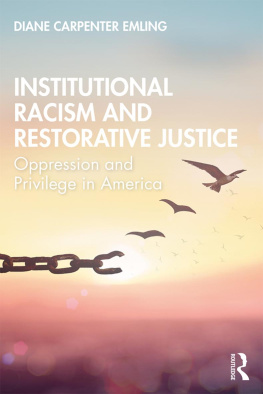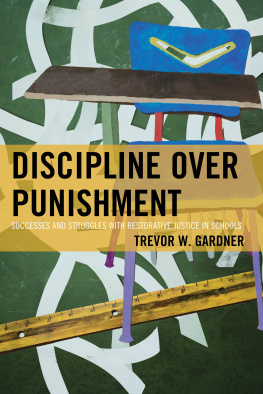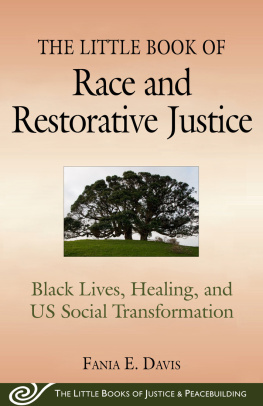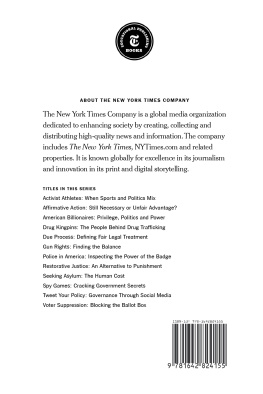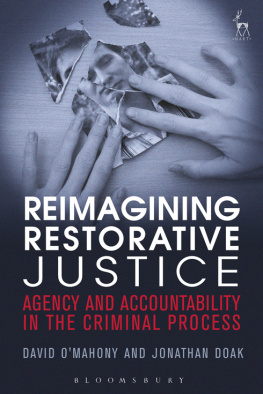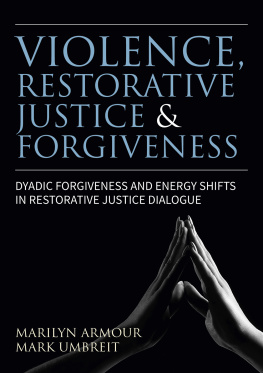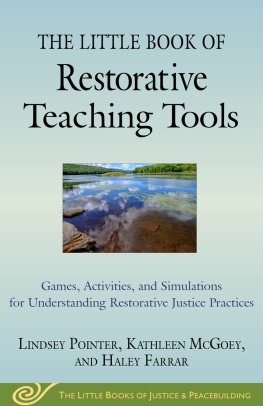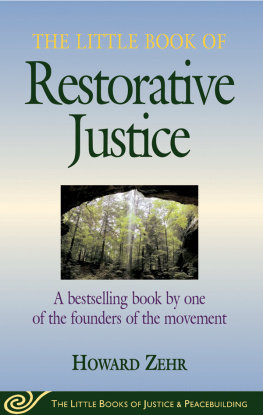INSTITUTIONAL RACISM AND RESTORATIVE JUSTICE
Invisible, intractable and deadlysuch is the nature of institutional racism. But are there mitigating actions that society could take against them? Diane Carpenter Emling explores this question in Institutional Racism and Restorative Justice: Oppression and Privilege in America. Moving beyond the immediate sources and consequences of prejudice, racism and inequality, to thoroughly assess approaches to restorative justice, Emling details Americas complex history of racism, demonstrating how it becomes embedded in society through land ownership, housing, education, health care, employment, public services and criminal justice. For each of these issues, she suggests actions to restore justice. But societies dont operate institution by institution, and extraordinary changes will be necessary to address systemic racism. Directed at college undergraduate students, Emlings book offers a valued contribution for teaching courses in African American studies, sociology, economics, politics and American history. Written in a comprehensive and accessible style, this book offers a much-needed perspective in the literature on institutional racism.
Diane Carpenter Emling holds a PhD in sociology, emphasizing political economy, from Michigan State University. She is retired from a 30-year career teaching sociology at Northwestern Michigan College in Traverse City, Michigan, as well as from adjunct teaching appointments at Michigan State Universitys James Madison College and School of Social Work, Ferris State University, and Grand Valley State University. Her activist work in Michigan involves her in many organizations.
INSTITUTIONAL RACISM AND RESTORATIVE JUSTICE
Oppression and Privilege in America
Diane Carpenter Emling
First published 2020
by Routledge
52 Vanderbilt Avenue, New York, NY 10017
and by Routledge
2 Park Square, Milton Park, Abingdon, Oxon, OX14 4RN
Routledge is an imprint of the Taylor & Francis Group, an informa business
2020 Taylor & Francis
The right of Diane Carpenter Emling to be identified as author of this work has been asserted by them in accordance with sections 77 and 78 of the Copyright, Designs and Patents Act 1988.
All rights reserved. No part of this book may be reprinted or reproduced or utilised in any form or by any electronic, mechanical, or other means, now known or hereafter invented, including photocopying and recording, or in any information storage or retrieval system, without permission in writing from the publishers.
Trademark notice: Product or corporate names may be trademarks or registered trademarks, and are used only for identification and explanation without intent to infringe.
Library of Congress Cataloging-in-Publication Data
A catalog record for this title has been requested
ISBN: 978-0-367-35566-1 (hbk)
ISBN: 978-0-367-34435-1 (pbk)
ISBN: 978-0-429-34029-1 (ebk)
Typeset in Bembo
by Lumina Datamatics Limited
I dedicate this book, first, to Tom Emling, who has enthusiastically encouraged any project I have chosen to undertake for nearly 50 wonderful years.
It is also dedicated to our two children, Timothy Emling and Stephen Emling, who survived living their growing-up years with a sociologist as their mother. As adults, both are thoughtful, caring and highly ethical gentle men who own my heart.
Finally, I dedicate this book to our dear friend and mentor Reverend John S. Duley, professor emeritus of Lifelong Education at Michigan State University, whose commitment to social justice is indefatigable.
CONTENTS
PART I
Concepts and Context
PART II
The Social Institutions at Work
PART III
So What Can We Do?
the problem of the Twentieth Century is the problem of the color-line.
W.E.B. DuBois, 1900
Thus spoke Americas greatest scholar of race, race relations and racism. A year later, he went on to note:
We seldom study the condition of the Negro today honestly and carefully. It is so much easier to assume that we know it all. Or perhaps having already reached conclusions in our own minds, we are loath to have them disturbed by facts.
Was the color line indeed the problem of the twentieth century? Yes and no. The problem of the twentieth century, and of other times as well, is the problem of inequality. DuBois was certainly well aware of this fact, for as Berch Berberoglu puts it, DuBois understood the dynamics of racism as a manifestation of class conflict (2017: 116). With that qualifier in mind, it seems that the color line was indeed the problem of the twentieth century, and it is shaping up to be the problem of the twenty-first century as well.
With respect to racism in the twentieth century, we find no less a scholar than Samuel Eliot Morison, once regarded as the pre-eminent American historian, referencing blacks as childlike, improvident, humorous, prevaricating, superstitious. Morison intimated that, as slaves, most blacks were pleased and contented (Stannard 1991:381). Morisons racist views came as late as 1965 in his highly regarded volume Oxford History of the American People.
One has little difficulty finding statements comparable to Morisons in todays popular press and social media and even in some so-called scholarly books and articles. In fact, even worse proclamations are not rare.
Bearing witness to such racist proclamations for decades moved scholars William H. Grier and Price M. Cobbs to opine just 3 years after Morisons statement that so much time has passed and so little has changed (1968: 1). Racism now runs rampant and with renewed and expanded institutional support will continue to do so. Over 50 years after Grier and Cobbs proclaimed that not much had changed, it appears that some things have changed but much remains the same, and the few things that did change for the better are now being rolled back (see Kendi 2016: ixxi).
For the greater part of the twentieth century did we, as social scientists and sociologists, do as DuBois would have us dohonestly and carefully study racism in its many manifestations? Not according to two of the finest scholars of race and racism ever produced by American sociology. Lewis Killian chastised his colleagues as follows:
In their optimism and eagerness to prove that assimilation could proceed rapidlygiven laws against discrimination and vigorous enforcement of the lawssociologists have failed to take due and realistic account of the depth of white prejudice and the short-sightedness of whites self-interest. (1971: 284)
Sidney M. Willhelm was even less charitable to his fellow sociologists:
Regardless of perspective, virtually all schools of thought among professional, orthodox sociologists have been racist by presenting interpretations that detect some specific quality among blacks themselves, rather than suggesting any responsibility among whites, for any difficulty that might impede further progress. (1979: 116)
The criticisms of Killian and Willhelm appeared in 1970s. Another noted student of race and racism tacked on this more recent assessment:
Since 1970, sociologists have continued to measure the degree of existing prejudice and discrimination, an always useful function, but they have had little else to say to the larger public or to the political, civic and educational leadership. (McKee, 2000: 389)


